Beethoven in Bonn (1770-1792)
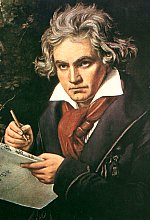
Ludwig van Beethoven
1819
Origin and childhood
Ludwig van Beethoven came from a musician family. His father and
Grandfather worked for the electors of Cologne, which residence was in
Bonn. The grandfather, Lodewyk van Beethoven (1712-1773), who came from
Mechelen in Belgium, joined the electoral orchestra as bass player in 1733.
In 1761 he became conductor. His son Johann (1740-1792) was soprano
at the age of eight and after the breaking of the voice tenor in the orchestra.
He played also piano and violin and could raise his salary by giving lessons.
In
November 1767, he married Maria Magdalena Leym, née Keverich,
a twenty-one-year-old widow. In April 1769, her first child was
born surviving only six days. On December 17th, Ludwig van Beethoven was
born in Bonn. Only two of his five younger brothers and sisters survived
the first years of their life, Caspar Anton Carl (1174-1815) and Nikolaus
Johann (1776-1848). They were very close to Ludwig all his life. The father
had discovered the outstanding talent of his son already early. He gave
him piano and violin lessons and tried to „commercialize" him as infant
prodigy after Mozart's example. On March 26th 1778, he presented
for the first time his „six-years-old little son" to the public - Ludwig
had his seventh birthday three months before. On early publication his
age is stated two years younger without exception.
Christian Gottlob Neefe's student
In 1779, the composer and organist Christian Gottlob Neefe (1748-1798)
came to Bonn as court organist and Ludwig became his student. In addition
to piano and organ lessons he taught him also thorough bass and composition
and helped him to publish his first works. He engaged him as assistant
organist in the court orchestra of Bonn and Beethoven stood often in for
his teacher also on the harpsichord.
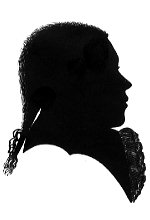
The sixteen-year-old Beethoven
in court dress (silhouette)
Through the work for High Masses on Sundays and holidays and the taking
part in concerts and at the theater, the young artist got in touch with
Haydn's and Mozart's music and with the works by composer from Mannheim
and Paris. His teacher acquainted him with the strict countersubject of
Johann Sebastian Bach. Through his compositions and his virtuoso piano
playing Beethoven attracted attention at the court of Bonn. The Elector
Maximilian Franz (1756-1801) was rather interested in his progress. In
spring 1787, he granted the seventeen-year-old a vacation for a
trip to Vienna to continue his studies with Mozart. But this project failed,
because Beethoven was called back to Bonn after a fourteen-day stay in
Vienna informed of the falling ill of his mother. A short time after his
return, his mother died on July 17th 1787.
Orchestral musician in Bonn
The new opera house in Bonn was inaugurated in 1789. Beethoven played several
years the viola in the opera orchestra. On the program were apart from
works by the popular composers Giovanni Paisiello (1741-1816) and Ignaz
Umlauff (1746-1796) also among other compositions Mozart's Entführung
aus dem Serail, Le Nozze di Figaro and Don Giovanni.
Beethoven's father was superannuated in November 1789. After the
death of the mother he was more and more addicted to drink and the care
of the brothers rested more and more upon the eldest son - Beethoven obtained
from the court that half the paternal salary was left to him for the maintenance
of the brothers.
Acquaintance of Haydn
In Dezember 1790, Joseph Haydn stopped in Bonn on his first journey to
London, Beethoven met him perhaps already at that time. But it is sure
that they met when Haydn went back to Vienna in summer 1792. Haydn offered
probably to give him lessons. The court of Bonn, particularly Elector Maximilian
Franz, considered also a study visit in Vienna with Haydn useful and so
they agreed upon that Beethoven should receive his salary from Bonn even
during the first time in Vienna. Early in November 1792 Beethoven left
Bonn and he arrived in Vienna on November 10th.
Beethoven in Vienna I (1792-1802)
Haydn's, Albrechtsberger's and Salieri's student
A short time after his arrival at the imperial city, Beethoven began
his musical studies with Haydn. The instruction in counterpoint
lasted intermittently until the beginning of 1794, when Haydn started
off on his second journey to London. Beethoven was not always satisfied
with Haydn's lax teaching methods. As Haydn had left Vienna, he began to
study counterpoint, canon and fugue with the well-known theorist Johann
Georg Albrechtsberger (1736-1809). But the relations with Haydn lasted
till his death in 1809 and were supposed to be quite friendly despite
some negative statements by Beethoven concerning his teacher. He owed undoubtedly
also the acquaintance of influential art lovers and patrons to Haydn.
The musician of Bonn found first accommodation with Prince Karl
Lichnowsky (1756-1814), in which town residence he was a welcome guest.
Baron Gottfried van Swieten (1733-1809) took also notice of Beethoven,
who was for the moment more known as piano virtuoso than as composer. The
friend and patron of Mozart supported the young pianist at the beginning
of his career in Vienna and Beethoven dedicated him his first symphony.
After the instruction in counterpoint with Haydn and Albrechtsberger,
Beethoven took Italian vocal and opera style lessons with the then court
conductor, Antonio Salieri (1750-1825). Later, he had no more significant
relations with the highly esteemed opera composer and it seems that Salieri
was rather prepossessed against him.
As freelance pianist in Vienna
In March 1794, Elector Maximilian stopped payments. At that time, Beethoven
depended no more upon the allowances of the court of Bonn. He was very
popular as piano teacher and gave lessons to several young ladies from
moneyed noble families. A short time later, his brother Caspar Carl went
to Vienna to live with him. The next year, Nikolaus Johann moved also to
the imperial city and worked here as assistant pharmacist.
During the first years in Vienna, Beethoven appeared as pianist
only in private circles. On March 29th 1795, he faced the Viennese audience
in his first public concert at the Burgtheater.
The first great success: „Die Geschöpfe des Prometheus" (1801)
After intensive work on the string quartets op 18, Beethoven ventured for
the first time on the composition of a symphony in 1799 - on April 2nd
1800, his first symphony op 21 was performed in the course of a benefit
concert at the old Burgtheater. But only his ballet music „Die Geschöpfe
des Prometheus" op 43 meant the breakthrough as composer for him. It was
a commissioned work of the famous dancer, choreographer and composer Salvatore
Vigano (1769-1821). The première on March 28th 1801 was very successful,
the ballet was performed thirteen times this year and nine times the next
year.
In 1800-1802, he composed also the piano sonatas op 27 and op
28, the quintet op 29 and the violin romance op 40. In February 1802, he
finished the composition of the second symphony op 36, which was performed
for the first time just one year later, on April 5th 1803.
Beethoven's everyday life as composer
Despite the frequent changes of residence, Beethoven's daily routine did
not vary particularly. Usually, he spent the morning writing down his compositions
and went for long walks in the afternoon. He carried on him always a notebook
to note down new musical ideas. Either he spent the evenings with friends
or he stayed at home to read.
During the summer months, the composer left Vienna like most Viennese
and rented a lodging in the environs. On the one hand the country life
offered him more calm for his work, on the other hand the nobility stayed
also in summer at their country-seats and remaining in the capital would
have been of no financial use. He was often invited in the country by his
noble patrons, for instance by Lichnowsky or by Countess Anne Marie Erdödy
(1779-1837).
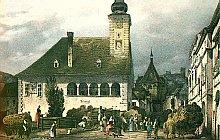
The place of Mödling
Mödling was Beethoven's favorite destination from 1818 to
1820
Concert tours
At the turn of the century it was no longer unusual, when important musicians
and composers toured in Europe to perform in different cities. But Beethoven
undertook only three concert tours: in spring 1796 to Prague, Dresden
and Berlin, in autumn 1796 to Bratislava and Pest (Budapest) and
in 1798 once more to Prague. His increasing deafness restrained
him probably from other tours.
The testament of Heiligenstadt
In a letter dated June 1801 to the physician Franz Wegeler (1765-1848),
a friend from his time in Bonn, Beethoven mentioned for the first time
the failure of his hearing. The problems arose already in 1797,
but only four years later he entrusted himself to some of his closest friends.
He consulted several physicians, but no one could help him. On
medical advice he moved in spring 1802 for six months to Heiligenstadt,
hoping that the seclusion would ease his illness. But he had to recognize
that the treatment had no success and he had to accept his worsened deafness.
On October 6th, he wrote in a state of deepest despair the „Heiligenstädter
Testament" (testament of Heiligenstadt) addressed to his two brothers.
He explained the reason for his unfriendly behavior recently and asked
them and his circle of friends for understanding for his hopeless situation.
Obviously, at that time, Beethoven had seriously in mind to put an end
to his life - he requested of his brothers to publish the letter after
his death. But in writing it down, he seems to have gathered fresh hope,
because he left Heiligenstadt not much later and returned to Vienna.

The Beethoven house
in Heiligenstadt
Beethoven in Vienna II (1802-1815)
After the difficult months in Heiligenstadt - the piano variations op 34
- 35 and the piano sonata op 31 were composed among others at this time
- he worked now with great energy on new works. In March 1803, he
finished the oratorio Christus am Ölberge op 85 and the third piano
concerto op 37. On April 5th 1803, these works and the Symphony no. 2 were
performed for the first time in a benefit concert at the Theater an der
Wien. Beethoven received for it about 1800 guldens.
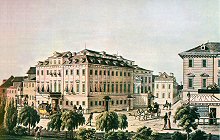
The Theater an der Wien
Among others, the Symphonies no. 3 and 6, the violin concerto
and the opera „Fidelio" were performed here for the first time
Spurred on by the success, he started to compose the violin sonata op
47, which he dedicated later to the French violinist Rodolphe Kreutzer
(1766-1831), and the third symphony op 55 („Eroica").
Since early this year, he was employed as composer at the Theater
an der Wien and a short time later he moved with his brother Caspar into
a company flat at the theater.
Fidelio
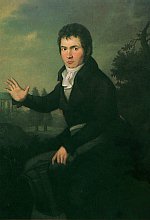
Beethoven in 1804 |
|
|
|
His contract with the Theater an der Wien expired in spring 1804, but
already early in September he was employed again by the theater. Beethoven
thought already for a while of composing an opera and, as Joseph Sonnleithner
(1766-1835), the secretary of the Viennese court theater, had written for
him the libretto of Leonore after a French model, he worked intensively
on the composition. The première was fixed on September 30th 1805,
but had to be postponed, because the theater censorship objected to it
and gave in only after a petition of Sonnleithner. Even the second deadline
could not be met, because Napoleon's armed forces had entered the imperial
city and Napoleon installed his headquarters at Schönbrunn castle.
The première of Leonore was actually performed on November 20th
1805, followed by two other performances. But Beethoven was not satisfied
with the work. He revised the piece several times and the text was also
modified again and again - his friend of Bonn Stephan von Breuning (1774-1827)
dealt with it among others. The final version with a new overture and entitled
Fidelio was performed for the first time only eight years later, on May
23rd 1814, at the Kärntnertortheater. It should remain his only
finished opera in spite of other opera projects of the composer. |
The Rasumovsky quartets
At the end of 1805, Count Andreas Kirillovich Rasumovsky (1752-1836),
the Russian envoy in Vienna, commissioned Beethoven to compose three string
quartets. At the end of November 1806, he finished the works known
under the name of „Rasumovskyquartette" op 59. The count was reputed to
be an educated art collector and music lover. From 1808 to 1816
he kept his own string quartet ensemble, conducted by the famous violinist
Ignaz Schuppanzigh (1776-1830), who made music also for Prince Lichnowsky
and belonged to Beethoven's circle of friends.
Commissioned to compose two symphonies
In summer 1806, the composer traveled with Prince Lichnowsky to
Silesia, the ancestral home of the family. Together they payed also a visit
to Count Franz von Oppersdorff (1778-1818), who kept a private orchestra
at his residence in Upper Silesia. Oppersdorff commissioned Beethoven to
compose two new symphonies (the Fourth op 60 and the Fifth op 67).
During this journey Beethoven got into serious arguments with
the prince and went immediately back to Vienna. They were both on bad terms
for a long time.
The end of the career as pianist
As a result of his deafness, Beethoven restricted more and more his pianistic
activities. Nevertheless, he was still superior to the other piano virtuosos
in the improvised playing. At the end of 1808, he still took the
solo part on the occasion of the première of his fourth piano concerto
op 58. His last public appearance on the piano took place on January 25th
1815, when he accompanied the lied Adelaide op 46 in a concert on the occasion
of the birthday of the Russian Empress. Except a few exceptions he stopped
slowly teaching, which was a burden to him anyhow. The composer and pianist
Ferdinand Ries (1784-1838), which father had given Beethoven violin lessons
in Bonn, continued to be his student and he gave Archduke Rudolf lessons
in theory of composition still until 1824.
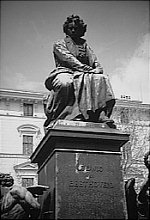
Beethoven-Denkmal
win der Wiener Innenstadt
Beethoven and Prince Lobkowitz
Prince Franz Joseph Maximilian von Lobkowitz (1772-1816) was one of the
most generous noble patrons of the Viennese musical life around 1800.
Many composers owed the securing of their living to his generous financial
supports, first of all Beethoven. In addition to Archduke Rudolf and Prince
Kinsky, he contributed to Beethoven's annuity since 1809. The prince
was a passionate violin player. He met Beethoven certainly soon after his
arrival in Vienna. Already in spring 1795, Beethoven appeared in „small
concerts" organized by the prince at the city residence of his family (Palais
Lobkowitz, Lobkowitzplatz 2, corner Augustinerstraße 2). In this
year, the prince supported the edition of his piano trios op 1 by subscription.
From 1796 on, Lobkowitz sustained a private orchestra at his city
palace. The next years, he spent much money for the performances of Joseph
Haydn's works. He converted the largest hall of the palace into a real
concert hall, divided in an orchestra pit and an auditorium. For invited
guests a multitude of concerts were given, from chamber music works to
symphonies and from operas to oratorios, they were all performed here.
The small Lobkowitz band was increased with Viennese musicians and singers
as occasion demands.
From 1803 on, Beethoven had also the princely band at his disposal.
He rehearsed at the city palace among other works his third symphony op
55 („Eroica") and the concerto for piano, violin and cello („triple concerto")
op 56 before their première. He dedicated the quartets op 18, the
triple concerto, the third (op 55), the fifth (op 67) and the sixth symphony
(op 68) and the lieder cycle „An die ferne Geliebte" to the prince. In
October 1804, the prince donated him 1,040 guldens for the dedications.
But despite his generous support, Beethoven was critical of the
prince and reminded him without hesitation, when he came in default with
his annual payments.
Beethoven in Vienna III (1812-1827)
In autumn 1812, Beethoven spent some weeks with his brother Nikolaus
Johann, who lived in Linz as pharmacist. During this sojourn, he wrote
his eighth symphony down. The fact that his brother lived together with
his housekeeper Therese Obermeyer was a thorn in his side. In this matter
he even called upon the competent bishop. Nikolaus married Therese on November
8th and after the solution of the problem Beethoven returned to Vienna.
In June 1813, the Duke of Wellington triumphed over Napoleon.
At the suggestion of the inventor Johann Nepomuk Mälzel (1772-1838),
Beethoven composed the „Schlachtensinfonie" op 91, „Wellington's victory".
Initially the piece was conceived for Mälzel's „Panharmonicon", a
mechanical musical instrument. In the orchestral adaptation it was performed
for the first time on December 8th together with the seventh symphony in
a charity concert and caused a tremendous sensation. In the orchestra,
which required an unusually large number of players for the „Schlachtensinfonie",
were the most famous musicians of Vienna, among others the composers Johann
Nepomuk Hummel and Antonio Salieri. The concert was repeated four days
later. The net proceeds of both performances of about 4,000 guldens was
for the benefit of war victims.
The great successes of the last years
Several magnificent concerts followed now. In February 1814, the
eighth symphony op 93 was performed for the first time and the Archduke
trio op 97 in April. Fidelio was entirely revised and was put on stage
on May 23rd at the Kärntnertortheater, Beethoven conducting. The second
performance on May 26th offered a new, the actual Fidelio overture (the
three previous overtures were called Leonore overtures). For the opening
of the Congress of Vienna in 1814, Beethoven composed the cantata „Der
glorreiche Augenblick" op 136, which was performed for the first time on
November 29th in the course of an academy at the Große Redoutensaal,
on the program: besides „Wellington's victory" also the seventh symphony.
The empresses of Austria and Russia, the king of Prussia and almost all
princely participants in the Congress of Vienna attended the concert, the
most famous musicians of Vienna played in the orchestra again.
The litigation about the guardianship
His brother Caspar Carl died on November 15th. Beethoven felt responsible
for his only child and strove for the sole guardianship, which entailed
protracted litigation with the mother of the boy. After exhausting lawsuits
through different instances, the sole care and custody was finally granted
to him in April 1820. An extensive letter of Beethoven, dated February
1820, to the municipal authorities of Vienna bespeaks his efforts in these
differences and shed light upon the uncompromising educational principles
of the composer.
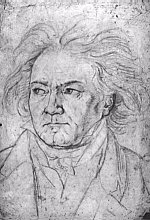
Beethoven around 1818
In 1816, Beethoven sent the boy for two years to a private reform
school. After his final examination, Karl went at first to the university
and then to the polytechnic. Worn down by the constant emotional stress,
he made a suicide attempt on July 30th 1826, that he survived fortunately.
The incident hit Beethoven hard. Now, he gave in the wish of his nephew
and allowed him to join the army.
Through the litigation about the guardianship Beethoven suffered
not only heavy financial losses, but his creativity was nearly paralyzed
too for a long time. His deafness was now coming up to a level, that he
could only communicate in writing with the people around him.
The last compositions

Beethoven on a stroll
(around 1820)
Missa solemnis and ninth symphony
The first sketches for the two greatest works by the „late" Beethoven,
the Missa solemnis op 123 and the ninth symphony op 125 were dated 1818/19.
Initially, the Mass should have been performed on March 9th 1820
on the occasion of Archduke Rudolf's enthronement as archbishop of Olomouc,
but Beethoven did not finish the composition in time. He worked intermittently
till 1823 on the work, which assumed unusual proportions. On March
19th, he handed a complimentary copy over to the archduke. In the hope
of receiving an appropriate fee, Beethoven offered the Missa solemnis also
to the Hungarian prince archbishop for the inauguration of the cathedral
of Gran (Esztergom), but the construction stagnated for many years and
the church was inaugurated only three decades after Beethoven's death in
1856.
From 1820 to 1822, he composed the last three piano sonatas op
109, 110 and 111. From May 1823 on, he worked intensively on the
ninth symphony and in late February 1824 he finished his probably most
known composition. The conversation notebooks give a clear idea of the
preparations on the occasion of the première of the work. In winter
1823/24,
leading personalities of the Viennese musical life published a letter to
the composer asking him to present his Missa solemnis and the symphony,
which he was about to finish, to the Viennese public. Beethoven was very
impressed by that, he deliberated the place and the date of the concert
with his friends and they agreed to organize the concert on May 7th
1824 at the Kärntnertortheater. Programmed were the overture op
124, parts of the Missa solemnis - the Kyrie, the Credo and the Agnus Dei
- and the ninth symphony. Ignaz Schuppanzigh was the concertmaster and
the conductor of the two Viennese court theaters Michael Umlauf (1781-1842)
conducted the performance with Beethoven's help. The theater was full and
the audience was enthusiastic about the music - and Beethoven was not able
to hear his applause.
But the financial success of the concert fell short of the expectations
of the organizers and as the performance was repeated two weeks later with
a slightly changed program at the Redoutensaal, the hall was only half-full.
The financial loss was borne by the director of the Kärtnertortheater,
Louis Antoine Duport.
The string quartets
Beethoven devoted the last three years of his life almost exclusively to
the composition of string quartets. He had never dealt before for such
a long time with a single genre. It is true that the six quartets op 18,
composed between 1798 and 1899 and dedicated to Prince Lobkowitz,
and the three „Rasumowsky quartets" op 59, composed in 1805/06,
were important works, but the last string quartets op 127, 130, 131, 132
and 135 can be regarded as the most personal and most moving expression
in Beethoven's works. Animated by the fact that Prince Nikolaus Galitzin
(1794-1866) from Saint Petersburg, who exchanged letters with the composer
since 1822, commissioned a composition from him, Beethoven composed the
quartet in E flat major op 127. After having finished it early in 1825,
he tackled the quartet in A minor op 132 and started at the same time to
compose the quartet in B-flat major op 130, which first version he finished
still in November 1825. As finale for this work he composed a great fugue,
which he considered then finally as independent work and published it as
op 133. The three quartets op 127, 130 and 132 are dedicated to the patron
Prince Galitzin. The following year he composed the quartets in C sharp
minor op 131 and in F major op 135.
Disease and death
The constant worries about his nephew overshadowed the last years of Beethoven's
life. Diseases too played him more and more up: An abdominal dropsy was
added to a hepatic cirrhosis. In autumn 1826, he accepted an invitation
of his brother Johann Nikolaus and spent with his nephew some weeks at
his country estate in Gneixendorf near Krems. He finished there the newly
composed finale of op 130. On December 1st, he traveled back to Vienna
in an open coach despite biting cold and contracted a pneumonia, which
he survived fortunately, but which aggravated also the dropsy and the liver
disease. On January 3rd 1827, he wrote down his last will. On March 26th,
he died in his apartment at the Schwarzspanierhaus.
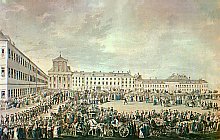
Beethoven's obsequies
On March 29th, he was buried at the cemetery of Währing,
over 20,000 people were present at the ceremony equaling a state ceremony.
At the entrance of the cemetery the actor Heinrich Anschütz recited
a commemorative address written by Grillparzer. On June 21st 1888,
Beethoven's mortal remains were transferred to the Wiener Zentralfriedhof
(central cemetery of Vienna).

|









